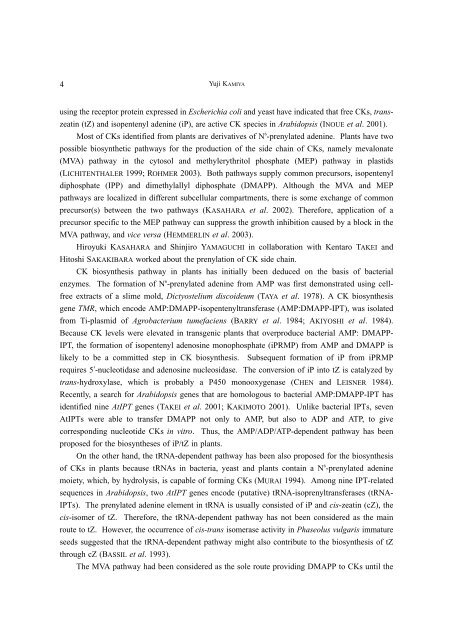No.42 - è¾²æ¥çç©è³æºç 究æ
No.42 - è¾²æ¥çç©è³æºç 究æ
No.42 - è¾²æ¥çç©è³æºç 究æ
You also want an ePaper? Increase the reach of your titles
YUMPU automatically turns print PDFs into web optimized ePapers that Google loves.
4<br />
Yuji KAMIYA<br />
using the receptor protein expressed in Escherichia coli and yeast have indicated that free CKs, transzeatin<br />
(tZ) and isopentenyl adenine (iP), are active CK species in Arabidopsis (INOUE et al. 2001).<br />
Most of CKs identified from plants are derivatives of N 6 -prenylated adenine. Plants have two<br />
possible biosynthetic pathways for the production of the side chain of CKs, namely mevalonate<br />
(MVA) pathway in the cytosol and methylerythritol phosphate (MEP) pathway in plastids<br />
(LICHITENTHALER 1999; ROHMER 2003). Both pathways supply common precursors, isopentenyl<br />
diphosphate (IPP) and dimethylallyl diphosphate (DMAPP). Although the MVA and MEP<br />
pathways are localized in different subcellular compartments, there is some exchange of common<br />
precursor(s) between the two pathways (KASAHARA et al. 2002). Therefore, application of a<br />
precursor specific to the MEP pathway can suppress the growth inhibition caused by a block in the<br />
MVA pathway, and vice versa (HEMMERLIN et al. 2003).<br />
Hiroyuki KASAHARA and Shinjiro YAMAGUCHI in collaboration with Kentaro TAKEI and<br />
Hitoshi SAKAKIBARA worked about the prenylation of CK side chain.<br />
CK biosynthesis pathway in plants has initially been deduced on the basis of bacterial<br />
enzymes. The formation of N 6 -prenylated adenine from AMP was first demonstrated using cellfree<br />
extracts of a slime mold, Dictyostelium discoideum (TAYA et al. 1978). A CK biosynthesis<br />
gene TMR, which encode AMP:DMAPP-isopentenyltransferase (AMP:DMAPP-IPT), was isolated<br />
from Ti-plasmid of Agrobacterium tumefaciens (BARRY et al. 1984; AKIYOSHI et al. 1984).<br />
Because CK levels were elevated in transgenic plants that overproduce bacterial AMP: DMAPP-<br />
IPT, the formation of isopentenyl adenosine monophosphate (iPRMP) from AMP and DMAPP is<br />
likely to be a committed step in CK biosynthesis. Subsequent formation of iP from iPRMP<br />
requires 5’-nucleotidase and adenosine nucleosidase. The conversion of iP into tZ is catalyzed by<br />
trans-hydroxylase, which is probably a P450 monooxygenase (CHEN and LEISNER 1984).<br />
Recently, a search for Arabidopsis genes that are homologous to bacterial AMP:DMAPP-IPT has<br />
identified nine AtIPT genes (TAKEI et al. 2001; KAKIMOTO 2001). Unlike bacterial IPTs, seven<br />
AtIPTs were able to transfer DMAPP not only to AMP, but also to ADP and ATP, to give<br />
corresponding nucleotide CKs in vitro. Thus, the AMP/ADP/ATP-dependent pathway has been<br />
proposed for the biosyntheses of iP/tZ in plants.<br />
On the other hand, the tRNA-dependent pathway has been also proposed for the biosynthesis<br />
of CKs in plants because tRNAs in bacteria, yeast and plants contain a N 6 -prenylated adenine<br />
moiety, which, by hydrolysis, is capable of forming CKs (MURAI 1994). Among nine IPT-related<br />
sequences in Arabidopsis, two AtIPT genes encode (putative) tRNA-isoprenyltransferases (tRNA-<br />
IPTs). The prenylated adenine element in tRNA is usually consisted of iP and cis-zeatin (cZ), the<br />
cis-isomer of tZ. Therefore, the tRNA-dependent pathway has not been considered as the main<br />
route to tZ. However, the occurrence of cis-trans isomerase activity in Phaseolus vulgaris immature<br />
seeds suggested that the tRNA-dependent pathway might also contribute to the biosynthesis of tZ<br />
through cZ (BASSIL et al. 1993).<br />
The MVA pathway had been considered as the sole route providing DMAPP to CKs until the













